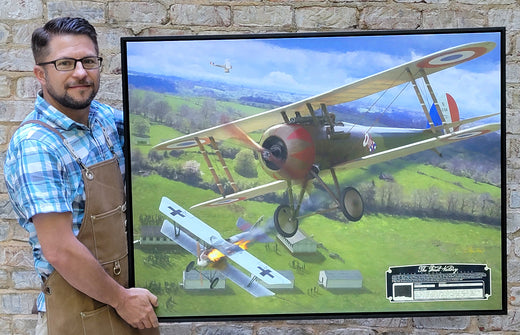This Fine Art Print by Artist Craig Tinder honors 2LT Douglas Campbell's first enemy victory in WWI in his Nieuport 28c.1 fighter aircraft. This art piece was created with the support of Hangar 743 and the Collings Foundation through their restoration work of America's oldest airworthy fighter aircraft - Nieuport No. 512 which is restored in the markings of 2LT Douglas Campbell's aircraft. This extremely rare, Limited Edition canvas print includes an original remnant of fabric linen from Nieuport 28c.1 No. 512.
Details About the RELIC:
Displayed on a metallic dataplate, this WWI linen fragment was removed during the flying restoration work on Nieuport 28 No. 512. This piece of linen comes from the horizontal stabilizer and was removed by Mikael Carlson in Sebbarp, Sweeden during the aircraft's 2019-2022 restoration. With it's original nine-cylinder Gnome Monosoupape 9N rotary engine, the aircraft took to flight in 2022 donning the livery of 2 LT Douglas Campbell's aircraft N.6164 as it appeared on 14 April 1918. The aircraft is on display at the American Heritage Museum in Stow, MA.
 Tail section of Nieuport No. 512
Tail section of Nieuport No. 512
 Horizontal stabilizer - before fabric removal
Horizontal stabilizer - before fabric removal
 Large section of horizontal stabilizer linen as used in canvas art print "The First Victory"
Large section of horizontal stabilizer linen as used in canvas art print "The First Victory"
 Backside of Nieuport linen
Backside of Nieuport linen
 Artist, Craig Tinder, holding linen fragment from the Nieuport that is used in the limited edition prints
Artist, Craig Tinder, holding linen fragment from the Nieuport that is used in the limited edition prints
The Story Behind the Print:
On April 14, 1918, 2LT Douglas Campbell of the 94th Aero Squadron, famously known as the "Hat in the Ring" gang, intercepted his first enemy aircraft over the skies near Toul, France. Flying a Nieuport 28c.1, Campbell was part of one of the earliest American fighter squadrons deployed to the Western Front in World War I. That same day, Campbell and fellow squadron member 2LT Alan Winslow achieved the squadron’s first confirmed aerial victories, marking a significant milestone in the unit's history. Their success signaled the arrival of American pilots in the skies of Europe, as they joined the fight against seasoned German forces.
 2LT Douglas Campbell - America's First Ace from an American Unit
2LT Douglas Campbell - America's First Ace from an American Unit
Campbell's aircraft, a nimble Nieuport 28c.1, was unique during this engagement. Unlike most of the aircraft in his squadron, Campbell's Nieuport was outfitted with only a single machine gun rather than the standard two. Despite this limitation, he demonstrated remarkable skill and precision, downing his first enemy aircraft on what was also the 94th Aero Squadron’s inaugural combat patrol. Campbell’s ability to secure victory under such conditions quickly set him apart as one of America’s most promising fighter pilots.
Campbell's success continued, and by May 31, 1918, he achieved his fifth confirmed kill, earning the prestigious title of “ace.” This made him the first American pilot from an American unit to reach ace status, a significant accomplishment that bolstered the morale of the U.S. forces. His sixth and final victory came shortly after, on June 5, 1918, cementing his reputation as one of the finest American aviators of the war. Campbell’s achievements came at a crucial time for the Allied forces, as the tide of the war was slowly turning against Germany.
 Aerial photograph of Toul, France American Air Base - 1918
Aerial photograph of Toul, France American Air Base - 1918
To ensure the accuracy of this painting, artist Craig Tinder collaborated with Rob Collings of the Collings Foundation, who provided access to the original WWI barracks layout map and personal accounts from 2LT Campbell and his parents. Campbell’s letters home offered firsthand details about the weather, altitude, and the events of that historic day, which Tinder meticulously incorporated into his artwork. These primary sources, combined with the layout map, helped bring authenticity to the piece, allowing the painting to capture the moment with unparalleled precision. This attention to detail not only honors Campbell’s legacy but also ensures the historical accuracy of the scene.
Nieuport No. 512, the same model flown by 2LT Douglas Campbell during his historic combat missions in World War I, has been restored to flying status and is now the oldest airworthy American fighter aircraft in existence. This remarkable aircraft, painstakingly preserved and maintained, serves as a living piece of aviation history, allowing enthusiasts to witness firsthand the type of fighter that helped shape early American air combat.
Upon the release of this print, the great-great grandson, namesake Douglas Campbell, of 2LT Douglas Campbell became the proud owner of an early edition number of "The First Victory" canvas. As Army Aviator, it's an honor for him to have one of these prints.
 Douglas Campbell - Great-Great Grandson of America's First Ace
Douglas Campbell - Great-Great Grandson of America's First Ace
To purchase or see similar items, visit here.
Commissioned by Museums, Treasured by Collectors





Share:
Sherman in Battle, the story behind "Operation Bluecoat"
American Air Power, the story behind "American Evolution"